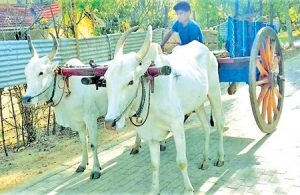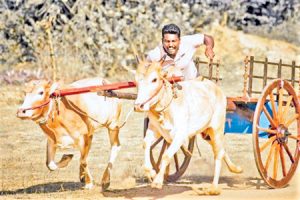The Northern Province is home to various traditional skills, some of which have become extinct. In this digital era, most of our working systems have some element of modern technology. Thankfully some traditions are upheld, taking us back in time. This narrative is from four visits to the villages of Araly and Vaddukoddai.
Having heard of an old blacksmith’s forge where everything is still crafted by hand, my friend Terry and I set off to inspect this ancient tradition. Cycling towards the quiet village of Moolai was in itself a wonderful experience, passing fields of red onions and clusters of palmyrah trees. On reaching Moolai we stopped and inquired about the forge, from an old man.
After weeks of searching for this location, we finally arrived at the home of Nathan, the last blacksmith of Moolai.
Flames of grit

Cart with two bulls.
The old forge was surrounded by trees, which provided shade. A man wearing a blue sarong was busy with a hammer. Another young man clad in trousers walked up to us and inquired if we wanted to place an order. He was surprised that we had come from Colombo to write about his uncle’s forge.
Shortly, a man wearing thick spectacles emerged from the rear of the forge. His hands were calloused and rough, but he had an amiable smile. He motioned us to come forward and said, “I am Nathan; my generations have worked this forge for the past 140 years. My grandfather had learnt this art from his father. He later trained my father. I first picked up a hammer as a schoolboy. Since then I have been able to work along with my four brothers”.
It is a tradition in the North for families to work together. The forge attracts customers from many villages, including Jaffna town, even as far as the islands of Delft and Karainagar. Nathan invited me to stand next to the bellows- a large apparatus consisting of three leather bags, stitched and held in formation by strips of softwood. When Punniyam (the assistant blacksmith) pulled on the wooden handle the bag sucked in the air and released it via a thin pipe.
The pipe opens into a small pit where charcoal embers infused with air breathe orange flames. Nathan heats a rectangular iron piece until it glowed red. He placed it on the heavy anvil. Within seconds he hammered with speed and dexterity to transform the iron into a blade, dipping the blade into a bucket of water. Punniyam chewed on betel leaves, his teeth stained red by this practice.
Punniyam brought a large rim of iron, which had to be fitted onto the wheel of a bullock cart. Sudhaharan arranged coconut husks in a circular design and filled the centre with charcoal and dried hay. The rim was placed on the husks and covered with more hay. Punniyam lit the fire. The men worked and the rim settled on the wooden wheel.
Skill and will
A fence made with dried palmyrah fronds separated the forge, from a garden where palmyrah trees rose majestically reaching into the sunlight. Under the shade of a massive khomba tree, a bare-bodied man in a sarong was busy using a cloth to clean a large wheel. He stood up and smiled saying, “I saw you at my brother’s forge. This is where I make the wooden items to supplement Nathan’s iron blades. We make handles for the knives and axes. But my main skill is making bullock carts, which take almost 25 to 30 days.”

Speed and grace
For centuries the bullock cart was the mode of transport, from hardworking farmers to proud village chieftains. Ramachandran said, “To make a whole bullock cart costs about 150,000 rupees. We do everything by hand.
When the cart is complete we invite the customer to the kovil next door and deliver the cart after a short prayer. We also serve sweet Pongal (a rice-based food infused with jaggery and raisins). This is the passion with which we work.” Half an hour later two majestic white bulls arrived at the forge, with an older man and a young boy. The bulls are tied to the yoke and the cart slowly rolls onto Araly road.
Some years from now this forge may become silent. The work of these ironsmiths will be remembered in the village of Moolai.
Bull races
A few days later I encountered a young man named Thanaraj. He is a young man who lives out an adventure that most city youth cannot imagine. Having earned his trust, he agreed to take me to his village of Kottai- Kaddu, which is on the southern border of Vaddukoddai. The village according to oral tradition derives its name from an old rock formation where a small Fort had stood centuries ago. Today the remnants of the Fort are no more and the area is in a dense thicket of trees, hence the name Kottai (Fort) within the Kaddu (forest).
There is not much beauty in this area, but it is famous for a few families who live here maintaining a very old Tamil tradition- the skill of racing bullock carts. There are still a few families in Kottai- Kaddu who have for generations managed to sustain their identity and passion. The history of cart racing is popular in many countries-.
The Tamil tradition of cart racing is very popular in India with grand races taking place. Yet the pulse of bull racing in Jaffna and other areas is making a resurgence. The Vaddakan breed of cattle has its origins in the Vanni region and Mannar. Here they are bred in herds and left to forage in large gardens, under the shade of Palmyrah trees. Another young man explained “Our bulls are special to us. We feed them on a careful diet of punnac, gram and flour which is pounded from paddy.
The food is given to them in a dry thick paste – this is to ensure that the nutrition is absorbed rapidly by the animal. Water is given from time to time. We want these bulls to be in good condition. The cart races take place on Sundays. Sometimes we have to travel to Mannar or other locations like Madhagal, Sanguveli, Alaveddi, Atchuvely, Pandaitherruppu and Neerveli. The day before the race we bathe the bulls”.
That evening there was a practice race in the Kottai- Kaddu area for us to witness. Some robust bulls were being exercised by the owners.
An old man decided to join the conversation and shared his experience. He said “Today the boys take the bulls and carts by lorry to the race locations. Then the bulls are rested. In my day we had to travel a day or two before the race, to rest and be ready for the race. It was nice to travel at night with the light from lanterns. We stopped and cooked our rice on the way. We made large buckets of tea (with no sugar) and gave the bulls to drink hours before the race. Like for a human, the tea soothes the animal”.
It was time to walk through a fence into a large dry area. Many had gathered to see the practice run, and few had come to see us! The bulls were tied to the cart. The wheels were given a final inspection. A flag was waved. The bulls and riders sprang into action. It was amazing to see this – My first bullock cart race in Jaffna. The riders angled dangerously above the bulls. This is the thrill of racing. An exciting evening. The sunset over the village of Kottai- Kaddu. The carts slowly passed by. The wheels kept turning beyond the sunset.
Dishan Joseph




